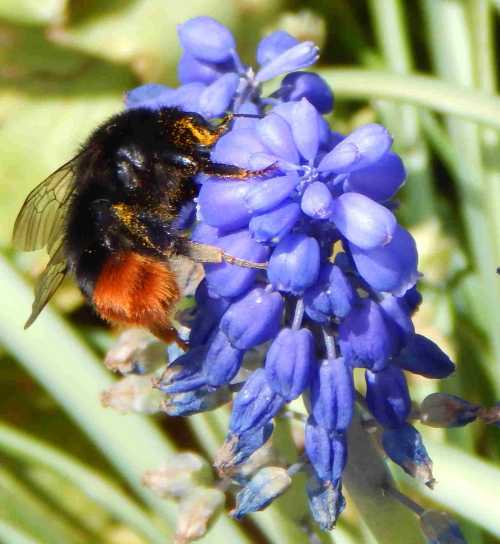Why Clover Is Great For Bees
For years I have advocated clover for use in lawns not only in private gardens, but also by local council and government bodies on public stretches of land.
Clover is very beneficial for bees and pollinators, but also offers major practical benefits, such as drought tolerance and low maintenance.
However, here we're going to look at why clover is so great for bees, which bees feed on it, and related questions.
Which Bees Feed On Clover And What Is The Best Clover For Bees?
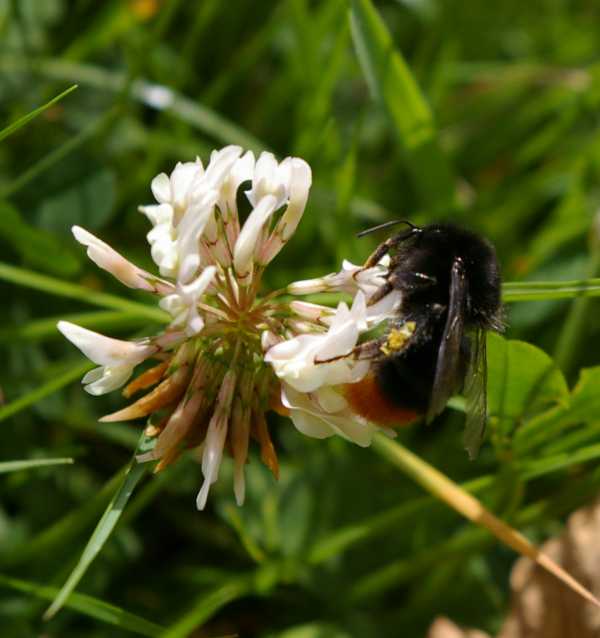 Bumble bees love clover
Bumble bees love cloverBumble bees and honey bees are especially fond of clover.
From personal observation, bees will visit both red and white clover, but there are differing opinions on the web.
Research suggests:
- White and red clover are important sources of nectar and pollen for bumble bees.
Studies suggest this is the case at least in the UK, USA, New Zealand and Sweden1. - Clover species are also important for providing honey bee forage1.
 Honey bee foraging on white clover
Honey bee foraging on white cloverSome solitary bees feed on clover too, such as the Blue Mason Bee, Osmia caerulescens.
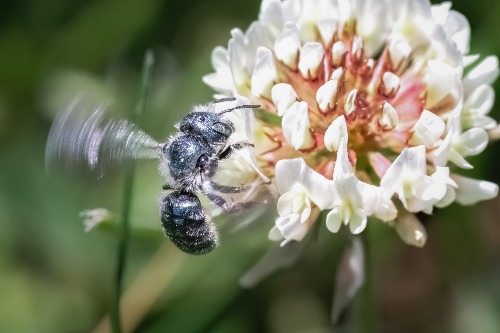 The Blue Mason Bee, Osmia caerulescens foraging on clover.
The Blue Mason Bee, Osmia caerulescens foraging on clover.Which clover varieties are best for bees and pollinators?
You can't go wrong with either of these varieties:
- Red Clover (Trifolium pratense)
- White Clover Seed (Trifolium repens)
- Crimson Clover Seed (Trifolium incarnatum)
It's possible to purchase seeds, and some suppliers also provide plug plants.
I'm seeing plenty of clover about, why do I need to add it to my lawn?
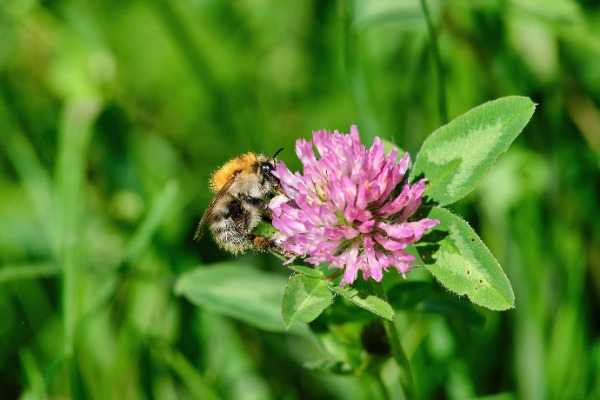 Common Carder Bumble Bee - Bombus pascuorum on clover.
Common Carder Bumble Bee - Bombus pascuorum on clover.There is now less clover growing in the environment than previously.
Research evidence also tells us the following:
- the decline of white clover in the twentieth century is suggested to be a contributing factor to national extinctions of bees and other aculeate Hymenoptera and flower visiting insects over that period1.
- Reductions of clover content of grasslands may have detrimental effects on insects by decreasing available floral resources, or by increasing competition for alternative resources1.
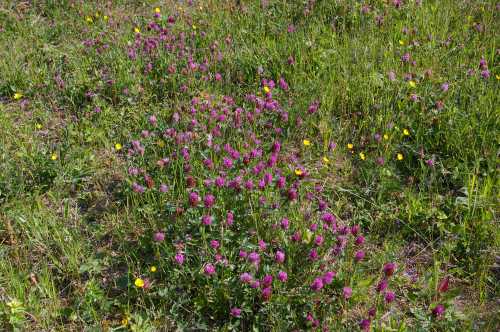 Clover is often seen on scrubby waste ground(as pictured here), but it can also flourish in the lawn, and grows in patches.
Clover is often seen on scrubby waste ground(as pictured here), but it can also flourish in the lawn, and grows in patches.Is the clover in your lawn any good for bees?
We have patches of white clover (along with Self heal (Prunella vulgaris and daisies) growing in our lawn, and the clover certainly attracts bees.
The clover established itself naturally.
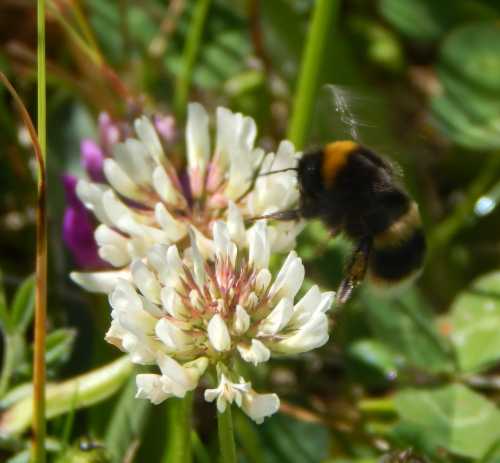 Bees visit the white clover that grows in my lawn.
Bees visit the white clover that grows in my lawn.If you have clover growing in your lawn already, then great, watch out for visits from bees!
You don't need to replace it with any particular variety, because it will most likely be a type that is well adapted to the growing conditions provided.
If you're not seeing visits from pollinators, there could be multiple reasons, including:
- you have simply missed them when they were foraging, or the flowers are not yet at their stage of maximum attractiveness to bees (in terms of nectar and pollen offering);
- the patch of clover is a little sparse - let it spread!
- see more possible reasons: Where have all the bees gone?
Taking care of clover in your lawn
Once clover is established in your lawn, it's easy to look after, especially because it is quite drought resistant.
Therefore, simply allow it to flourish in the lawn, and mow around it whilst its in full flower.
Thankfully, clover is low growing, and doesn't look too messy.
Can honey bees make honey from clover?
Clover honey is a popular honey variety in North America.
In her 1976 work: Honey. A comprehensive survey, Eva Crane2 suggested that white clover is of major important source of nectar flow for beekeepers. (Crane founded the Bee Research Association in 1949, which later became the International Bee Research Association).
Clover honey from a single source can be strongly flavoured, although it is often blended and becomes milder in taste.
(See where clover honey ranks in sweetness versus other honey variants).
What is the difference between red clover and white clover and are they of equal benefit to bees?
The sugar in nectar provides vital energy for bees, and differing levels of sugar within nectar may suggest that not all nectars offer the same vital calorie benefits to pollinators.
Research has produced varying and sometimes contradictory results with regard to measured nectar rewards from clover for pollinators.
For example, one study from 19523 measured the sugar content present within nectar secreted from various flowers, including red and white clover.
The scientists monitored the sugar content of nectars on 3 separate occasions.
From the study, it seemed that white clover may offer a higher sugar content than red clover.
The sugar levels for red and white clover were as follows:
Total sugars: g/100ml
White clover (Trifolium repens):
39.3g;
32.6g;
25.4g
Red clover (Trifolium pratense):
29.6g;
8.3g;
15.9g.
However, a later study in 20164 measured 'Mean volume
of nectar sugar per flower per day (µg/day)' and 'Floral
unit longevity (in days)'.
It found that red clover offered a significantly higher quantity of nectar sugar (at 48.366 (µg/day)) than white clover (12.135 (µg/day)).
White clover had a slightly longer floral longevity than red clover (two days per unit vs just over one and a half days for red clover).
White clover provided more pollen than red clover, but only slightly.
Why the difference?
One consideration (my own theory) could be that flower performance may relate to growing conditions, and that both red and white clover potentially offer similar benefits to bees, provided that they are growing in environments in which they flourish.
A further factor may relate to the quality of seed planted, and the health of the stock from which the seed was gathered.
References
1. Harris, C., Ratnieks, F.L.W. Clover in agriculture: combined benefits for bees, environment, and farmer. J Insect Conserv 26, 339–357 (2022).
2. Crane E (1976) Honey. A comprehensive survey. Heinemann Publishing, Portsmouth.
3. The Sugar Content of Nectars BY G. R. WYKES Bee Research Department, Rothamsted Experimental Station; July 1952.
4. Hicks DM, Ouvrard P, Baldock KC, et al. Food for Pollinators: Quantifying the Nectar and Pollen Resources of Urban Flower Meadows. PLoS One. 2016;11(6):e0158117. Published 2016 Jun 24. doi:10.1371/journal.pone.0158117

